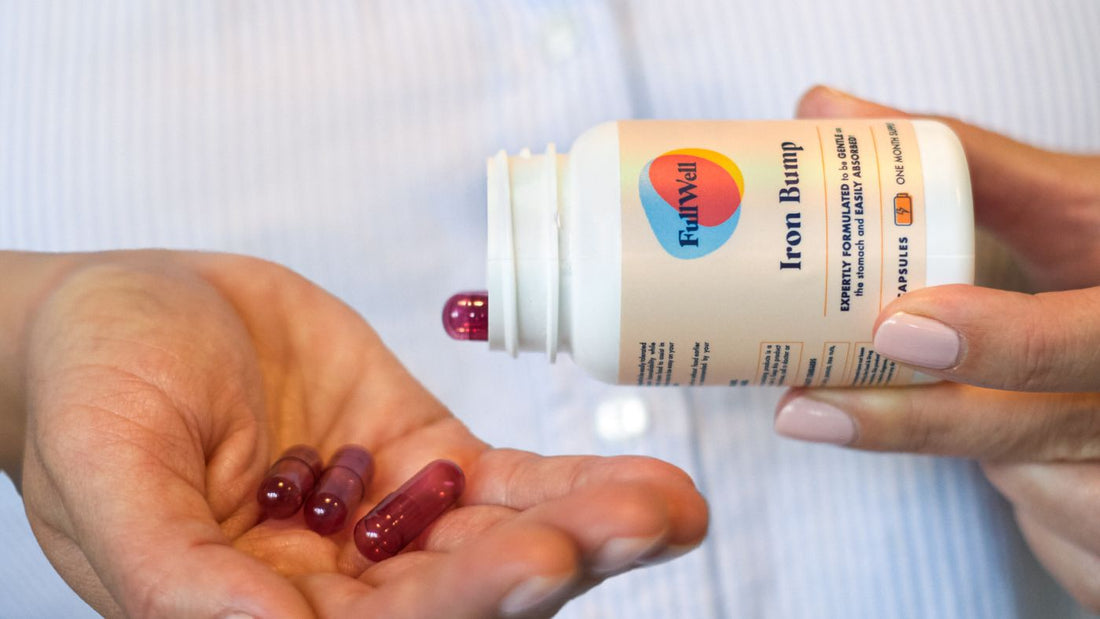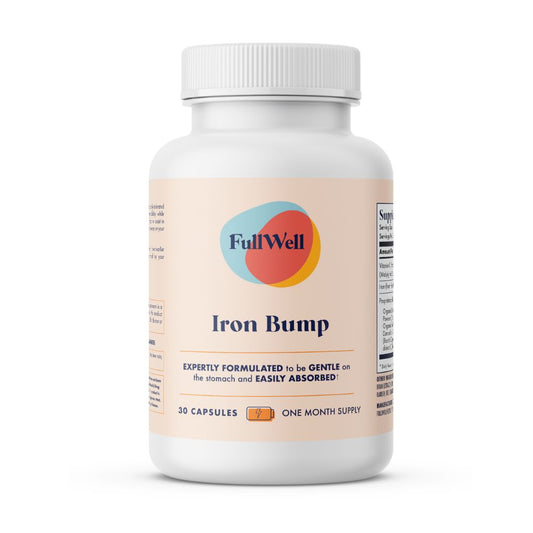The Science Behind Our Iron Bump
Read more

Did you know iron is needed to build healthy blood and transport oxygen to tissues? This critical function is essential at all stages of life, particularly during pregnancy when blood volume nearly doubles. Iron also aids normal thyroid function, placental development, and energy metabolism. Babies need iron for proper neurodevelopment and to achieve a healthy birth weight. All of this to say, iron is super important!
The absolute best time to evaluate your iron status is before you even start trying to conceive so that you can get ahead of the game. While trying to conceive, you should be aware of your iron intake through food and consider taking additional steps with your Registered Dietitian or Doctor if your lab results show room for improvement. This is the most straightforward stage to fix iron levels while on your pregnancy journey, as the stakes are relatively low (barring you suffering from any symptoms). Working with your healthcare provider to get your levels within range is the first and most productive step you can take.
The National Institutes of Health recommends roughly 18 mg of iron per day for non-pregnant women, 27 mg per day for pregnant women, and 9 mg per day for lactating women (1). Even before pregnancy, deficiency is common for various reasons, including diet. Many women adhere to specific diets that, by nature, lack sufficient iron, putting them at a much greater risk for iron deficiency.
The average non-pregnant adult woman holds about 300mg of stored iron in her body (which, in context, is enough to last for about six months). As we'll explain below, not all of us fall into that “average” category. During pregnancy, your needs increase so rapidly to begin providing for baby that you can quickly run through your stores and still have trouble catching up and getting enough iron during pregnancy, which could lead to iron deficiency anemia. If untreated, this could increase mom’s susceptibility to infection and impact energy levels, breastmilk production, and mood. For babies, mom’s iron deficiency can affect their iron stores during the first few months of their life, impacting weight and brain development.
During pregnancy, you need a significantly more significant amount of iron than non-pregnant women because the amount of blood in your body increases to provide for yourself and your baby (1). The amount of iron needed varies depending on the trimester, with moms losing an estimated 230 mg of iron over the nine months of pregnancy (2). Creating the placenta and baby requires around 360 mg of iron, and an additional 450 mg is needed to increase the number of red blood cells in the mother's bloodstream during pregnancy (2). It's recommended to add at least 1g of iron during pregnancy to support the healthy development of both the mom and baby (2).
How well the body can handle the extra needs during pregnancy depends on iron stores at the beginning of pregnancy and how much iron from food can is absorbed during pregnancy (3). The way the body absorbs iron changes during pregnancy. In the first trimester, iron absorption decreases, but then it gradually increases for the rest of the pregnancy (3). In order to meet your requirements, it is estimated that women must go into pregnancy with iron stores ≥300 mg (3).

During the first trimester of pregnancy, the recommended iron intake (approximately 0.8 mg per day) is less than before pregnancy because women are no longer menstruating (2). As a result, the plasma volume also increases and continues to expand until the 30th to 34th week, resulting in a 30-50% greater volume than in non-pregnant women (2). It is estimated that daily needs of around 4 to 5 mg of iron per day are sufficient for the second trimester (3). It is also during the second trimester that iron requirements increase and continue to rise for the remainder of pregnancy (3). During the third trimester of pregnancy, baby’s growth accelerates as this is the stage of pregnancy where most of the iron transfer from mom to baby occurs. The body's iron requirements increase to 3.0-7.5 mg per day (2, 3), reaching as high as 10 mg per day during the last 6 to 8 weeks of pregnancy (3). The third trimester is also when hepcidin (the iron-shut-off-valve that tells your body to store iron when there is too much in your bloodstream) is the lowest (4), increasing the amount of iron in the bloodstream.
During vaginal birth, the average blood loss is approximately two cups, while with cesarean delivery, it is twice that amount (5). Adequate iron is needed postpartum to help counteract this blood loss during delivery. The average maternal blood loss is equivalent to iron losses of around 150 mg, with an additional 90 mg in both the placenta and umbilical cord (6).
After delivery, iron helps rebuild blood lost during delivery and the normal phase of bleeding, known as lochia, which can last for several weeks. Iron losses generally begin to decrease during postpartum and lactation. Breastmilk, for example, has very little iron (0.4 mg/L) (7). When combined with the absence of menstruation, the majority of losses are canceled out, except when breastfeeding combines with the return of mom’s menstrual cycle (3). Mothers who have low iron levels during and after birth may experience symptoms such as fatigue, cognitive changes, and depression.
Postpartum anemia usually results from 1) being iron deficient before becoming pregnant, 2) continued inadequate iron intake during pregnancy, and 3) the blood loss experienced during delivery (8). This triple whammy produces the exact combination of circumstances that lead to postpartum anemia, which can impact mood, stress resiliency, energy levels, and cognition.
In simple terms, research shows that the body absorbs less iron in the early months of pregnancy. Still, this absorption increases in the second trimester and continues until the end of pregnancy as needs increase. After giving birth, iron absorption stays high in the first few months, helping the body rebuild its iron stores (3).
The recommended daily intake for iron during pregnancy (27 mg per day) is higher than the estimated requirements per trimester as they take into account factors like variation in individual needs (including iron stores pre-pregnancy) and differences in absorptive capacity to ensure that the body has enough iron to support both mom and baby. These recommendations aim to provide a safety buffer to ensure that needs are met regardless of individual variations. Working with your healthcare practitioner to monitor your iron status and establish a plan that is right for you is an essential step in your preconception and pregnancy journey. If you’re searching for a practitioner, check out our Practitioner Directory.